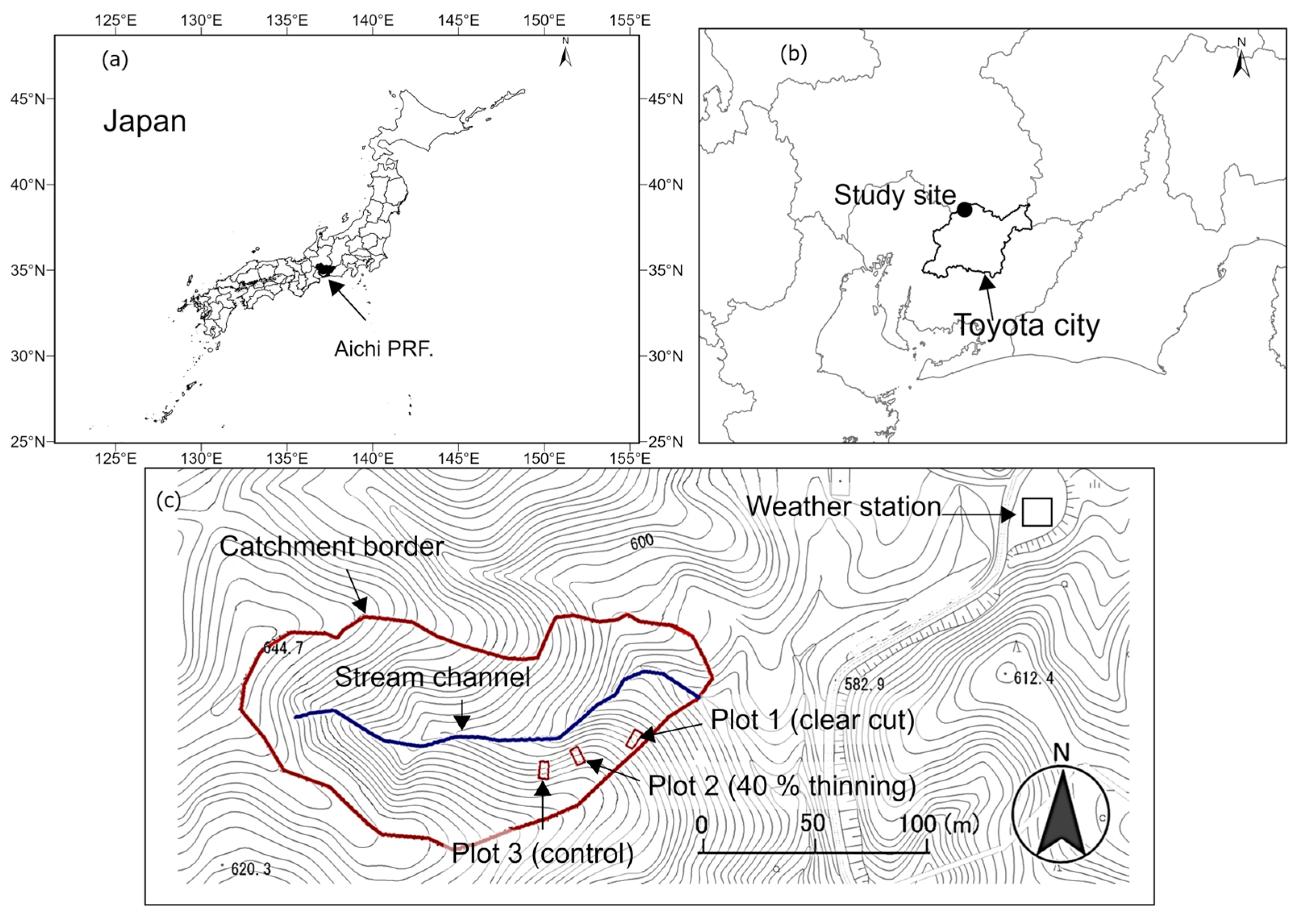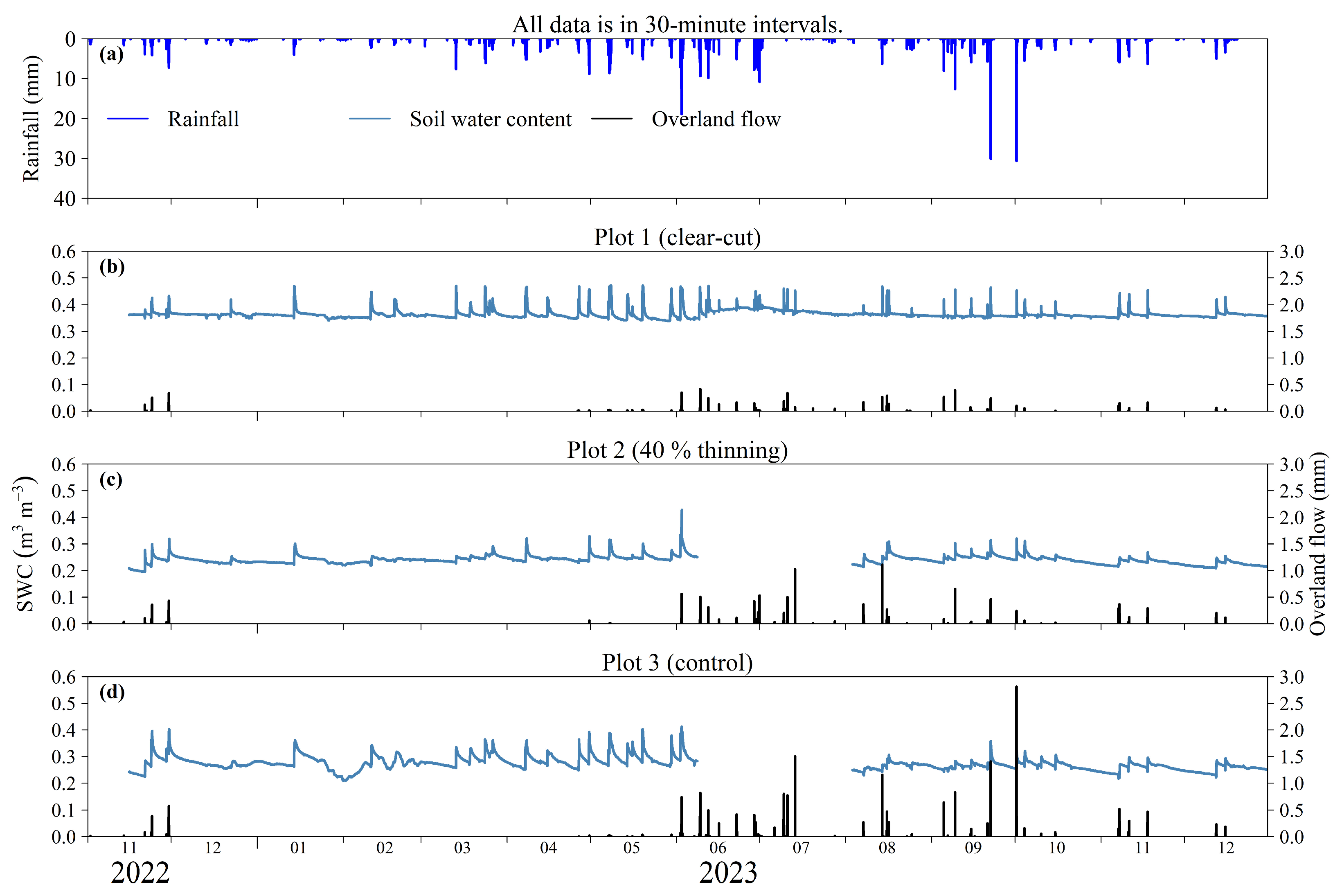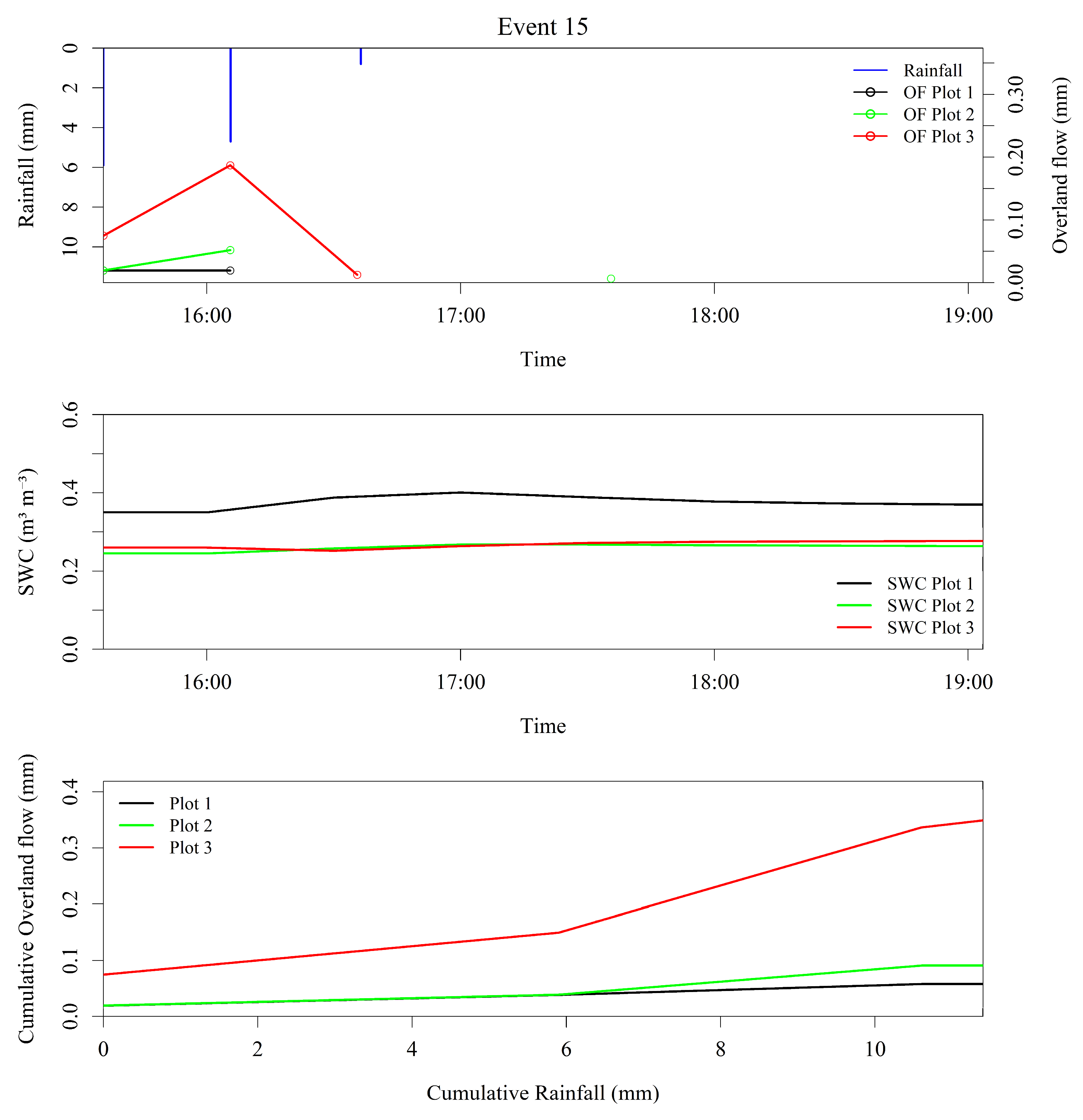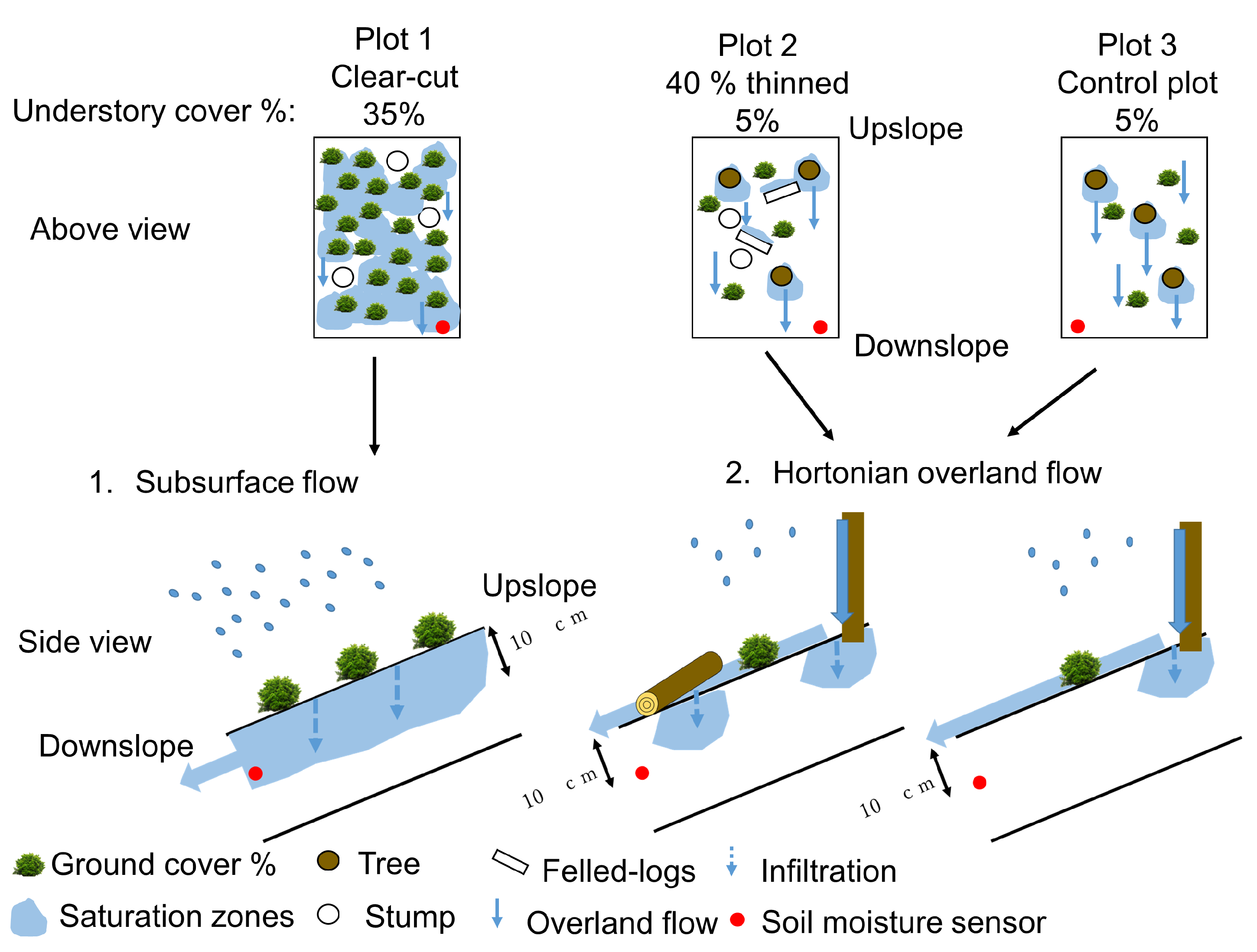Overland Flow Generation Under Clear-Cut, 40% Thinning, and Control Conditions in a Japanese Cypress Plantation
Abstract
1. Introduction
2. Materials and Methods
2.1. Study Site
2.2. Slope Soil Properties
2.3. Study Plots
2.4. Measurements
2.4.1. Overland Flow and Rainfall
2.4.2. Soil Water Content
2.5. Statistical Analyses
3. Results
3.1. Rainfall-Overland Flow Events
3.2. Overview of Rainfall, Overland Flow, and Soil Water Content
3.3. Mechanism of Overland Flow Generation
Correlation Between Overland Flow and Event Characteristics
3.4. High-Amount vs. High-Intensity Rainfall Events
4. Discussion
5. Conclusions
Author Contributions
Funding
Data Availability Statement
Acknowledgments
Conflicts of Interest
References
- Bruijnzeel, L.A.; Mulligan, M.; Scatena, F.N. Hydrometeorology of tropical montane cloud forests: Emerging patterns. Hydrol. Process. 2011, 25, 465–498. [Google Scholar] [CrossRef]
- Koyanagi, K.; Andreoli, A.; Nordio, G.; Pitscheider, F.; Tomelleri, E.; Comiti, F. Disturbance-intervention interactions on post-windthrow hillslope runoff and erosion processes in the Eastern Italian Alps. J. Hydrol. 2025, 656, 133001. [Google Scholar] [CrossRef]
- Sadeghi, S.H.R.; Khazayi, M.; Mirnia, S.K. Effect of soil surface disturbance on overland flow, sediment yield, and nutrient loss in a hyrcanian deciduous forest stand in Iran. Catena 2022, 218, 106546. [Google Scholar] [CrossRef]
- Tamer, M.; Adego, E.; Abiyu, A. Understanding rainfall runoff dynamics across various land uses and landscape positions in North Western Ethiopia. Sci. Rep. 2025, 15, 15287. [Google Scholar] [CrossRef] [PubMed]
- Japan Forestry Agency. Annual Report on Forest and Forestry in Japan Fiscal Year 2022 (Summary); Ministry of Agriculture, Forestry and Fisheries: Tokyo, Japan; Japan Forestry Agency: Chiyoda, Japan, 2023; p. 42. Available online: https://www.maff.go.jp/e/data/publish/attach/pdf/index-193.pdf (accessed on 23 July 2024).
- Kubota, T.; Tsuboyama, Y.; Nobuhiro, T. Effects of thinning on canopy interception loss, evapotranspiration, and runoff in a small headwater Chamaecyparis obtusa catchment in Hitachi Ohta Experimental Watershed in Japan. Bull. For. For. Prod. Res. Inst. 2018, 17, 63–73. [Google Scholar]
- Dung, X.B.; Miyata, S.; Gomi, T. Effect of forest thinning on overland flow generation on hillslopes covered by Japanese cypress. Ecohydrology 2011, 4, 367–378. [Google Scholar] [CrossRef]
- Iwakiri, K.; Ito, S.; Mitsuda, Y.; Hirata, R. Short-term effects of different thinning methods on degradation and recovery of understory vegetation of a hinoki (Chamaecyparis obtusa) plantation. Veg. Sci. 2019, 36, 43–59, (In Japanese with English Abstract). [Google Scholar]
- Junsuk, K.; Kubota, T.; Shiraki, K. Long-term effects of thinning on runoff change from coniferous forest plantations in headwater catchments. Hydrol. Res. Lett. 2025, 19, 72–79. [Google Scholar] [CrossRef]
- Japan Forestry Agency. Annual Report on Forest and Forestry in Japan Fiscal Year 2023 (Summary); Ministry of Agriculture, Forestry and Fisheries: Tokyo, Japan; Japan Forestry Agency: Chiyoda, Japan, 2024; p. 15. Available online: https://www.maff.go.jp/e/data/publish/attach/pdf/AnnualReportonForestandForestryinJapan_FY2023_web.pdf (accessed on 4 September 2025).
- Farahnak, M.; Tanaka, N.; Sato, T.; Nainar, A.; Gomyo, M.; Kuraji, K.; Suzaki, T.; Suzuki, H.; Nakane, Y. Enhancing Overland Flow Infiltration through Sustainable Well-Managed Thinning: Contour-Aligned Felled Log Placement in a Chamaecyparis obtusa Plantation. Sustainability 2023, 15, 14124. [Google Scholar] [CrossRef]
- Kuraji, K.; Gomyo, M.; Nainar, A. Thinning of cypress forest increases subsurface runoff but reduces peak storm-runoff: A lysimeter observation. Hydrol. Res. Lett. 2019, 13, 49–54. [Google Scholar] [CrossRef]
- Asano, Y.; Mizuuchi, Y.; Kishimoto, K.; Tanaka, N.; Bunte, K. Changes in sediment discharge over the 20th century from a mountain catchment that has experienced severe anthropogenic disturbances. Earth Surf. Process. Landf. 2025, 50, e6071. [Google Scholar] [CrossRef]
- Monger, F.; Bond, S.; Spracklen, D.V.; Kirkby, M.J. Overland flow velocity and soil properties in established semi-natural woodland and wood pasture in an upland catchment. Hydrol. Process. 2022, 36, e14567. [Google Scholar] [CrossRef]
- Miyata, S.; Onda, Y.; Gomi, T.; Mizugaki, S.; Asai, H.; Hirano, T.; Fukuyama, T.; Kosugi, K.; Sidle, R.C.; Terajima, T.; et al. Factors affecting generation of Hortonian overland flow in forested hillslopes: Analysis of observation results at three sites with different geology and rainfall characteristics. J. Jpn. For. Soc. 2009, 91, 398–407, (In Japanese with English Summary). [Google Scholar] [CrossRef]
- Castillo, V.M.; Martinez-Mena, M.; Albaladejo, J. Runoff and soil loss response to vegetation removal in a semiarid environment. Soil Sci. Soc. Am. J. 1997, 61, 1116–1121. [Google Scholar] [CrossRef]
- Farahnak, M.; Sato, T.; Tanaka, N.; Nainar, A.; Chaus, I.M.; Kuraji, K. Impact of thinning and contour-felled logs on overland flow, soil erosion, and litter erosion in a monoculture Japanese cypress forest plantation. Water 2024, 16, 2874. [Google Scholar] [CrossRef]
- Kottek, M.; Grieser, J.; Beck, C.; Rudolf, B.; Rubel, F. World map of the Köppen-Geiger climate classification updated. Meteorol. Z. 2006, 15, 259–263. [Google Scholar] [CrossRef] [PubMed]
- JMA (Japan Meteorological Agency). The Normal Value of Toyota City, Aichi Prefecture. 2020. Available online: https://www.data.jma.go.jp/stats/etrn/view/nml_amd_ym.php?prec_no=51&block_no=0464&year=&month=&day=&view= (accessed on 26 September 2024). (In Japanese)
- Tobe, H.; Chigira, M.; Doshida, S. Comparisons of landslide densities between rock types in weathered granitoid in Obara village, Aichi prefecture. J. Jpn. Soc. Eng. Geol. 2007, 48, 66–79, (In Japanese with English Abstract). [Google Scholar] [CrossRef]
- Forest Soil Division. Classification of forest soil in Japan (1975). Bull. Gov. For. Exp. Stn. 1976, 280, 1–28, (In Japanese with English Summary). [Google Scholar]
- IUSS Working Group WRB. World reference base for soil resources 2014, update 2015: International soil classification system for naming soils and creating legends for soil maps. World Soil Sci. Res. 2015, 106, 192. [Google Scholar]
- Farahnak, M.; Sato, T.; Otani, Y.; Kuraji, K.; Suzaki, T. The Differences in Water Repellency in Root Mat (Biomat) and Soil Horizons of Thinned and Non-thinned Chamaecyparis obtusa (Siebold et Zucc.) Endl. Plantations. Forests 2023, 14, 210. [Google Scholar] [CrossRef]
- Prosdocimi, M.; Jordán, A.; Tarolli, P.; Keesstra, S.; Novara, A.; Cerdà, A. The immediate effectiveness of barley straw mulch in reducing soil erodibility and surface runoff generation in Mediterranean vineyards. Sci. Total Environ. 2016, 547, 323–330. [Google Scholar] [CrossRef]
- Gomi, T.; Sidle, R.C.; Ueno, M.; Miyata, S.; Kosugi, K.I. Characteristics of overland flow generation on steep forested hillslopes of central Japan. J. Hydrol. 2008, 361, 275–290. [Google Scholar] [CrossRef]
- Levia, D.F.; Germer, S. A review of stemflow generation dynamics and stemflow-environment interactions in forests and shrublands. Rev. Geophys. 2015, 53, 673–714. [Google Scholar] [CrossRef]
- Moody, J.A.; Shakesby, R.A.; Robichaud, P.R.; Cannon, S.H.; Martin, D.A. Current research issues related to post-wildfire runoff and erosion processes. Earth-Sci. Rev. 2013, 122, 10–37. [Google Scholar] [CrossRef]
- Lee, H.H.; Shibano, H. Hydraulic characteristics of storm water flowing through litter layer. J. Jpn. For. Soc. 1990, 72, 223–229. (In Japanese) [Google Scholar]
- Sidle, R.C.; Hirano, T.; Gomi, T.; Terajima, T. Hortonian overland flow from Japanese forest plantations—An aberration, the real thing, or something in between? Hydrol. Process. 2007, 21, 3237–3247. [Google Scholar] [CrossRef]
- Leuteritz, A.; Gauthier, V.A.; van Meerveld, I. Spatial and Temporal Variability in Event Water in Near-Surface Flow Pathways in a Humid Steep Headwater Catchment. Hydrol. Process. 2025, 39, e70186. [Google Scholar] [CrossRef]
- Ide, J.; Shinohara, Y.; Higashi, N.; Komatsu, H.; Kuramoto, K.; Otsuki, K. A preliminary investigation of surface runoff and soil properties in a moso-bamboo (Phyllostachys pubescens) forest in western Japan. Hydrol. Res. Lett. 2010, 4, 80–84. [Google Scholar] [CrossRef]
- Badoux, A.; Witzig, J.; Germann, P.F.; Kienholz, H.; Lüscher, P.; Weingartner, R.; Hegg, C. Investigations on the runoff gen-eration at the profile and plot scales, Swiss Emmental. Hydrol. Process. 2006, 20, 377–394. [Google Scholar] [CrossRef]
- Farahnak, M.; Mitsuyasu, K.; Hishi, T.; Katayama, A.; Chiwa, M.; Jeong, S.; Otsuki, K.; Sadeghi, S.M.M.; Kume, A. Relationship between very fine root distribution and soil water content in pre-and post-harvest areas of two coniferous tree species. Forests 2020, 11, 1227. [Google Scholar] [CrossRef]
- Miyata, S.; Kosugi, K.I.; Gomi, T.; Mizuyama, T. Effects of forest floor coverage on overland flow and soil erosion on hillslopes in Japanese cypress plantation forests. Water Resour. Res. 2009, 45, W06402. [Google Scholar] [CrossRef]
- O′Loughlin, C.; Ziemer, R.R. The importance of root strength and deterioration rates upon edaphic stability in steepland forests. In Proceedings of the I.U.F.R.O. Workshop P.1.07-00 Ecology of Subalpine Ecosystems as a Key to Management, Corvallis, OR, USA, 2–3 August 1982; Oregon State University: Corvallis, OR, USA; pp. 70–78. [Google Scholar]






| Plot No. | Treatment 1 | Plot Area (m2) | Tree Density (Tree ha−1) | Understory Cover (%) | Slope Degree (Face) | Tree Height (m) | DBH (cm) |
|---|---|---|---|---|---|---|---|
| 1 | Clear-cut | 31.1 | 0 | 35.0 | 32° (NE) | 0 | 0 |
| 2 | 40% thinning | 30.8 | 649 | 5.0 | 37° (NW) | 13.7 | 17.2 |
| 3 | Control | 32.1 | 974 | 5.0 | 37° (NW) | 14.3 | 21.8 |
| Events | Rain Amount | Rain Duration | Rain Intensity | OF Plot 1 | OF Plot 2 | OF Plot 3 |
|---|---|---|---|---|---|---|
| mm | h | mm h−1 | mm | mm | mm | |
| 1 | 15.80 | 12.52 | 1.26 | 0.15 | 0.27 | 0.17 |
| 2 | 31.60 | 15.97 | 1.98 | 0.32 | 0.79 | 0.80 |
| 3 | 62.80 | 39.86 | 1.58 | 0.73 | 1.22 | 1.96 |
| 4 | 65.10 | 21.54 | 3.02 | 0.04 | 0.07 | 0.05 |
| 5 | 174.10 | 32.97 | 5.28 | 0.21 | 0.03 | 0.19 |
| 6 | 215.20 | 29.37 | 7.33 | 1.16 | 1.68 | 2.75 |
| 7 | 53.70 | 15.13 | 3.55 | 0.64 | 0.75 | 1.74 |
| 8 | 54.90 | 47.51 | 1.16 | 0.35 | 0.47 | 0.90 |
| 9 | 28.60 | 16.46 | 1.74 | 0.26 | 0.22 | 1.09 |
| 10 | 49.60 | 20.32 | 2.44 | 0.33 | 0.56 | 0.95 |
| 11 | 10.90 | 6.23 | 1.75 | 0.06 | 0.23 | 0.08 |
| 12 | 35.90 | 35.27 | 1.02 | 0.06 | 0.56 | 0.17 |
| 13 | 10.90 | 5.93 | 1.84 | 0.28 | 0.15 | 0.69 |
| 14 | 22.90 | 9.05 | 2.53 | 0.44 | 0.88 | 1.13 |
| 15 | 11.40 | 1.47 | 7.78 | 0.04 | 0.08 | 0.27 |
| 16 | 40.10 | 7.21 | 5.56 | 0.27 | 0.53 | 1.50 |
| 17 | 40.00 | 11.40 | 3.51 | 0.15 | 0.33 | 3.20 |
| 18 | 40.40 | 12.89 | 3.14 | 0.06 | 0.11 | 0.37 |
| 19 | 28.80 | 20.01 | 1.44 | 0.01 | 0.04 | 0.22 |
| 20 | 49.90 | 16.48 | 3.03 | 0.49 | 1.60 | 1.72 |
| 21 | 40.80 | 20.05 | 2.03 | 0.08 | 0.25 | 0.69 |
| 22 | 27.90 | 15.61 | 1.79 | 0.34 | 0.64 | 1.21 |
| Total rain | 1111.30 | Total OF | 6.46 | 11.45 | 21.88 | |
| OF rate (%) | 0.58 | 1.03 | 1.97 |
| Plot | Predictor | n | r | p-Value | Slope | Intercept | Significant |
|---|---|---|---|---|---|---|---|
| Plot 1 (clear-cut) | Total rainfall | 22 | 0.597 | 0.003 | 0.003 | 0.127 | ** |
| Rain duration | 22 | 0.317 | 0.151 | 0.007 | 0.154 | ns | |
| Average rain intensity | 22 | 0.289 | 0.192 | 0.042 | 0.171 | ns | |
| 10 min Max. rainfall | 22 | 0.251 | 0.261 | 0.003 | 0.191 | ns | |
| 30 min Max. rainfall | 22 | 0.339 | 0.123 | 0.018 | 0.130 | ns | |
| 60 min Max. rainfall | 22 | 0.401 | 0.064 | 0.012 | 0.126 | ns | |
| Initial SWC | 22 | −0.389 | 0.073 | −8.196 | 3.260 | ns | |
| Peak SWC | 22 | 0.418 | 0.053 | 4.612 | −1.729 | ns | |
| Plot 2 (40% thinning) | Total rainfall | 22 | 0.385 | 0.077 | 0.004 | 0.334 | ns |
| Rain duration | 22 | 0.268 | 0.227 | 0.011 | 0.316 | ns | |
| Average rain intensity | 22 | 0.146 | 0.516 | 0.036 | 0.413 | ns | |
| 10 min Max. rainfall | 22 | 0.230 | 0.304 | 0.004 | 0.357 | ns | |
| 30 min Max. rainfall | 22 | 0.267 | 0.230 | 0.025 | 0.298 | ns | |
| 60 min Max. rainfall | 22 | 0.312 | 0.157 | 0.016 | 0.295 | ns | |
| Initial SWC | 16 | −0.090 | 0.739 | −3.313 | 1.323 | ns | |
| Peak SWC | 16 | 0.392 | 0.133 | 4.686 | −0.851 | ns | |
| Plot 3 (control) | Total rainfall | 22 | 0.329 | 0.134 | 0.006 | 0.704 | ns |
| Rain duration | 22 | 0.074 | 0.745 | 0.005 | 0.892 | ns | |
| Average rain intensity | 22 | 0.278 | 0.210 | 0.126 | 0.624 | ns | |
| 10 min Max. rainfall | 22 | 0.549 | 0.008 | 0.019 | 0.285 | ** | |
| 30 min Max. rainfall | 22 | 0.626 | 0.002 | 0.107 | 0.045 | *** | |
| 60 min Max. rainfall | 22 | 0.750 | 0.000 | 0.072 | 0.010 | ** | |
| Initial SWC | 16 | 0.123 | 0.651 | 7.093 | −0.806 | ns | |
| Peak SWC | 16 | 0.209 | 0.438 | 3.425 | −0.056 | ns |
Disclaimer/Publisher’s Note: The statements, opinions and data contained in all publications are solely those of the individual author(s) and contributor(s) and not of MDPI and/or the editor(s). MDPI and/or the editor(s) disclaim responsibility for any injury to people or property resulting from any ideas, methods, instructions or products referred to in the content. |
© 2025 by the authors. Licensee MDPI, Basel, Switzerland. This article is an open access article distributed under the terms and conditions of the Creative Commons Attribution (CC BY) license (https://creativecommons.org/licenses/by/4.0/).
Share and Cite
Farahnak, M.; Ogura, T.; Tanaka, N.; Suzaki, T.; Kuraji, K. Overland Flow Generation Under Clear-Cut, 40% Thinning, and Control Conditions in a Japanese Cypress Plantation. Water 2025, 17, 3385. https://doi.org/10.3390/w17233385
Farahnak M, Ogura T, Tanaka N, Suzaki T, Kuraji K. Overland Flow Generation Under Clear-Cut, 40% Thinning, and Control Conditions in a Japanese Cypress Plantation. Water. 2025; 17(23):3385. https://doi.org/10.3390/w17233385
Chicago/Turabian StyleFarahnak, Moein, Takahiro Ogura, Nobuaki Tanaka, Toko Suzaki, and Koichiro Kuraji. 2025. "Overland Flow Generation Under Clear-Cut, 40% Thinning, and Control Conditions in a Japanese Cypress Plantation" Water 17, no. 23: 3385. https://doi.org/10.3390/w17233385
APA StyleFarahnak, M., Ogura, T., Tanaka, N., Suzaki, T., & Kuraji, K. (2025). Overland Flow Generation Under Clear-Cut, 40% Thinning, and Control Conditions in a Japanese Cypress Plantation. Water, 17(23), 3385. https://doi.org/10.3390/w17233385








